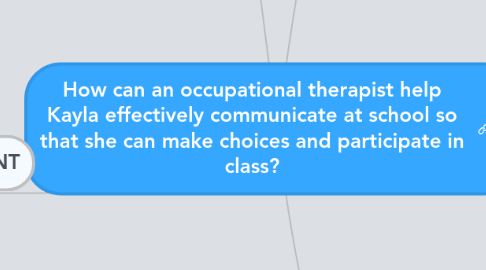
1. ASSESSMENT
1.1. Purpose: to assess Kayla's current communication skills, needs, and goals to help facilitate her access to face-to-face and written communication
1.2. Utilizing the Human Activity Assistive Technology (HAAT) Model
1.2.1. ACTIVITY
1.2.1.1. Self care
1.2.1.1.1. Dependent
1.2.1.2. Productivity
1.2.1.2.1. Weekly programs at Children's Centre
1.2.1.2.2. Going to school
1.2.1.3. Leisure
1.2.1.3.1. Daycare
1.2.2. HUMAN
1.2.2.1. Physical
1.2.2.1.1. Facilitators
1.2.2.1.2. Barriers
1.2.2.1.3. Still need to assess: coordination & range of motion
1.2.2.2. Cognitive
1.2.2.2.1. Facilitators
1.2.2.2.2. Barrier
1.2.2.2.3. Need to assess if Kayla can choose between more than 2 objects and how long she can concentrate on a task for
1.2.2.3. Emotional
1.2.2.3.1. Facilitator
1.2.2.3.2. Need to assess/ explore what Kayla likes and dislikes, and if there are potential sources of discomfort/ irritation that may affect her mood/ability to use AAC device.
1.2.2.4. Novice vs. expert user
1.2.2.4.1. Kayla has had some success using low-tech communication aids to make choices
1.2.3. CONTEXTS
1.2.3.1. Physical
1.2.3.1.1. Kayla currently uses a manual dynamic tilt wheelchair with a tray (operated by caregiver)
1.2.3.1.2. New school
1.2.3.1.3. Need to assess physical environment of Kayla's new school, particularly in the classroom(s) she will be in most of the days
1.2.3.2. Social
1.2.3.2.1. Kayla lives with a supportive family
1.2.3.2.2. Daycare
1.2.3.2.3. Augmentative Communication Services (ACS) team
1.2.3.3. Cultural
1.2.3.3.1. Possible stigma from peers
1.2.3.4. Institutional
1.2.3.4.1. Funding from ADP to lease a communication system
1.2.4. ASSISTIVE TECHNOLOGY
1.2.4.1. Kayla has a laptop and iPad
1.2.4.1.1. Unable to directly access these
1.2.4.2. Human-Technology Interface
1.2.4.2.1. "Jellybean" switch
1.2.4.3. Processor
1.2.4.3.1. Consult with SLP to determine type of processor of the AAC device
1.2.4.4. Activity outputs
1.2.4.4.1. Communication
1.2.4.5. Environmental Interface
1.2.4.5.1. Need to determine if Kayla would need environmental interfaces to augment vision
2. About Kayla
2.1. 6-year old girl
2.2. From Southwestern Ontario
2.3. Diagnosed with cerebral palsy (mixed type- hypotonia and dystonia), cortical visual impairment, and seizure disorder (seizures are now under control)
2.4. Will be starting Grade 1 in September (4 months from now)
3. By Jody Kai Yi Chan
4. NEXT STEPS
4.1. Next appointment
4.1.1. Assess:
4.1.1.1. Active range of motion of the wrist, elbow, shoulder, and neck joints to determine the most accessible and comfortable mounting position for the two switches
4.1.1.2. Hand, eye, and head coordination to determine if Kayla can successfully operate two switches consistently
4.1.1.3. Further assess Kayla's visual field to determine if she can attend to the AAC device. E.g. can show Kayla two pictures of toys for her to choose from at varying height levels, to determine optimal and consistent visual field for placement of the AAC device screen
4.1.2. Consult SLP to know and understand what communication system will be prescribed for Kayla
4.2. TREATMENT PLAN
4.2.1. Identify main occupational performance Issue (OPI)
4.2.1.1. Communicating her choices consistently with communication partners- with a focus on productivity at school (in line with Kayla's goals).
4.2.2. Optimize seating in wheelchair
4.2.2.1. Conduct seating assessment to determine proper seating to maximize comfort, attention span, respiration, circulation, and motor function; and decrease fatigue, tone, and pain (Beukelman & Mirenda, 1998)
4.2.2.1.1. Proximal stability will also optimize distal function
4.2.3. Mount AAC device prescribed by SLP
4.2.3.1. Ensure AAC device is stable, non-interfering, safe, flexible, and aesthetically pleasing (Goosen& Crain, 1992)
4.2.3.2. Explore using the best wheelchair mount to secure AAC device at Kayla's upper visual field (at the optimal height based on assessment findings)
4.2.4. Identify access points for switches
4.2.4.1. 4 considerations (Cook & Hussey, 1995)
4.2.4.1.1. 1) Movement pattern to access switch
4.2.4.1.2. 2) Site of contact with switch
4.2.4.1.3. 3) Interface/type of switch
4.2.4.1.4. 4) Position of switch
4.2.5. Collaborate with SLP to teach/train Kayla how to use the communication system and how to access it
4.2.6. Education of others
4.2.6.1. Guided by the Circles of Communication Partners (CCP) Model
4.2.6.1.1. Family
4.2.6.1.2. Teacher and EAs
4.2.6.1.3. Peers
4.2.6.1.4. Other health care professionals
4.2.6.1.5. Strangers
4.2.7. Throughout the whole treatment process:
4.2.7.1. Client and family-centred practice
4.2.7.1.1. Working as a team to develop treatment goals for Kayla
4.2.7.1.2. Collaborating with client and family throughout treatment process as they know client's needs best
4.2.7.2. Take a life course perspective
4.2.7.2.1. AAC devices are expensive
4.2.7.2.2. To meet Kayla's expanding communication needs
5. EVALUATION
5.1. of the effectiveness of the new communication system
5.2. Follow-up
5.2.1. to ensure that the new communication system/AAC device is working reliably
5.2.2. to assess if further training is necessary for Kayla, her teacher, EAs, family, and other communication partners
5.2.3. to answer any questions
5.2.4. to provide repair/maintenance or adjustments of the switches
5.2.5. Follow-up conducted 1 week after delivery and training (at clinic); then 1, 3 6, and 12 months later. Note that the 3rd month follow-up will be approximately when Kayla starts school. A follow-up at the school site may be necessary to ensure that the AAC device is working, and people around Kayla know how to use it.
5.2.5.1. For more long-term follow-up (i.e. 3, 6, 12 months), refer to and consult with school health OT to follow-up on whether AAC system is meeting Kayla's communication needs, and if modifications for access and positioning are necessary in Kayla's classroom setting.
5.2.5.1.1. From 3rd month follow-up and beyond, it is vital for school health OT to collaborate with teacher, EA, and possibly school health SLP to adapt and modify communication system to meet Kayla's growing communication goals (taking developmental and life-course perspective.
5.3. Outcome measures
5.3.1. Frequency of device use
5.3.2. Duration of device use
5.3.3. Goal oriented: frequency of Kayla making choices and participating in class
